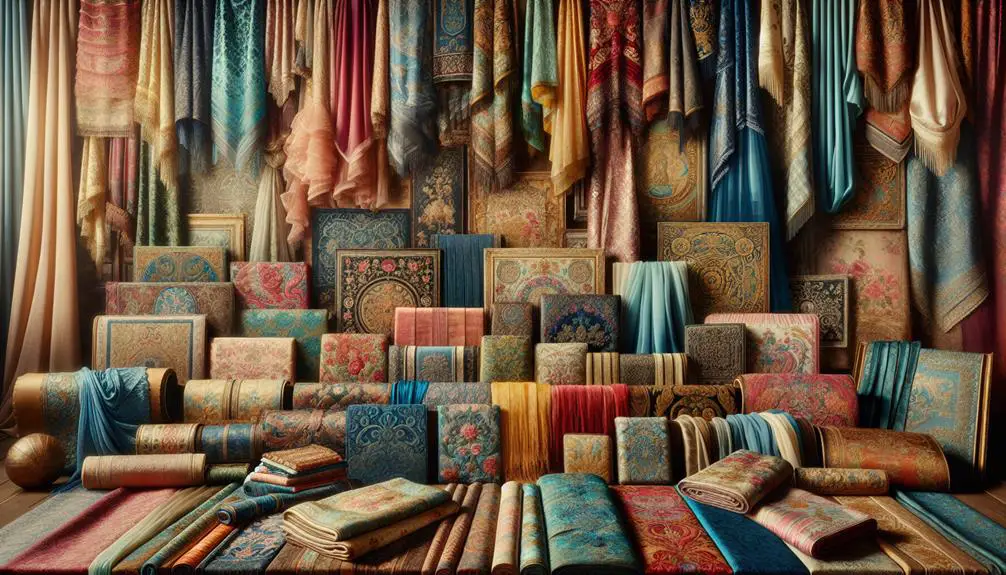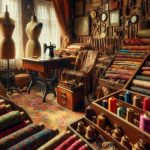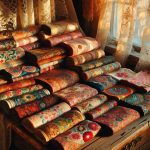You might say the fashion industry has found a new-old love in vintage fabrics. As you explore this trend, you'll notice how these textiles marry the charm of yesteryears with today's style demands. They aren't just about nostalgia; vintage fabrics offer sustainable choices and unique designs that set you apart. Curious about how you can identify and incorporate these timeless materials into your wardrobe? There's much more to uncover about their history, benefits, and modern applications.
Table of Contents
Key Takeaways
- Vintage fabrics blend past aesthetics with modern styles, creating timeless and trendy fashion pieces.
- They offer an eco-friendly alternative by repurposing materials and supporting sustainable fashion.
- Unique patterns and craftsmanship in vintage fabrics add distinctive charm to any wardrobe or home decor.
- Retro-inspired trends are making a strong comeback, with designers incorporating vintage fabrics into contemporary designs.
- Sourcing vintage fabrics from thrift stores, estate sales, and online platforms expands creative possibilities.
The Allure of Vintage Fabrics
With their unique patterns and rich history, vintage fabrics captivate both fashion enthusiasts and designers alike. You're drawn to these textiles not just for their aesthetic appeal but for the stories they tell. The allure of vintage fabrics lies in their ability to blend the past with the present seamlessly. When you incorporate vintage charm into modern interpretations, you're creating pieces that are both timeless and trendy. These fabrics allow you to stand out, offering a distinct flair that's hard to replicate with contemporary materials.
In today's world, where sustainable fashion is gaining momentum, vintage fabrics offer an eco-friendly alternative. By reusing and repurposing these textiles, you're contributing to a more sustainable industry. You're not just making a fashion statement; you're making a responsible choice. Vintage fabrics often come with superior craftsmanship, making them durable and long-lasting. This means you're investing in quality pieces that won't just fall apart after a few wears.
A Brief History
You'll find that vintage fabrics have fascinating origins and have evolved over time.
Iconic patterns like paisley and houndstooth have made significant comebacks, reflecting their timeless appeal.
Let's explore how these fabrics have journeyed through history and why they remain beloved today.
Origins and Evolution
Vintage fabrics have a rich history that dates back several centuries, reflecting the intricate craftsmanship and cultural influences of their time. You'll find that these fabrics often embody the cultural significance of the regions they originated from.
For instance, the luxurious silks from China weren't just textiles but symbols of wealth and status. Similarly, the woolen tartans of Scotland were more than just patterns; they represented clan identities and local heritage.
As you explore further into their evolution, you'll see how fashion influences played a pivotal role. The Renaissance period, for example, brought about an explosion of elaborate brocades and velvets, driven by a newfound appreciation for art and aesthetics.
Fast forward to the 20th century, and you'll notice a wave of synthetic fabrics like polyester emerging, transforming the fashion landscape yet again.
Understanding the origins of these fabrics isn't just about dates and places; it's about recognizing the stories woven into each thread. By appreciating this rich tapestry of history, you'll gain a deeper insight into why vintage fabrics are experiencing a trendy revival today.
They're not just materials; they're pieces of living history that continue to inspire modern fashion.
Iconic Patterns Revisited
Throughout the history of textile design, iconic patterns like paisley, polka dots, and florals have left an indelible mark on fashion and culture. These classic designs aren't just relics of the past; they've been revitalized with modern interpretations that seamlessly blend vintage aesthetics with contemporary flair.
You've likely noticed how paisley, with its teardrop-shaped motifs, has evolved from ancient Persian origins to the swinging sixties, and now, into today's haute couture.
Polka dots, once a symbol of playful elegance in the 1950s, have been reimagined with contemporary twists, appearing in unexpected color combinations and fabric textures.
Florals, perennial favorites, continue to bloom in fashion runways, offering fresh takes that range from oversized prints to minimalist, abstract representations.
These patterns are more than just designs; they're cultural artifacts that tell a story of their time while adapting to new contexts.
By mastering the art of incorporating these iconic patterns into your wardrobe or design projects, you're not just following a trend—you're embracing a rich tapestry of history, style, and innovation.
Embrace these classic designs with a discerning eye for modern interpretations, and you'll create a look that's both timeless and uniquely yours.
Popular Vintage Fabrics
You'll find that popular vintage fabrics like velvet, linen, and silk have made a significant comeback. Velvet offers a timeless appeal with its luxurious texture.
Meanwhile, linen's classic charm and silk's retro elegance continue to captivate fashion enthusiasts.
Timeless Velvet Appeal
Among vintage fabrics, velvet stands out for its luxurious texture and enduring elegance. You can't overlook velvet's resurgence in modern styling; it's making a grand comeback in both fashion and interior design. This plush fabric, once reserved for royalty, now commands a contemporary appeal that's hard to resist.
Imagine draping your living room in vintage velvet curtains or adorning your wardrobe with a classic velvet blazer—each piece adds an undeniable touch of sophistication.
Today's designers are adept at blending vintage velvet with modern aesthetics, creating pieces that are both timeless and on-trend. Picture a sleek, mid-century modern sofa upholstered in deep emerald velvet or a pair of velvet ankle boots paired with distressed jeans. The versatility of velvet allows you to incorporate it into your life without feeling dated.
Moreover, vintage velvet's soft, rich texture invites a tactile experience that few other fabrics can match. When you run your fingers over its surface, you're not just feeling fabric; you're touching a piece of history reimagined for today's standards.
With this fabric, you can master the art of blending old-world charm with contemporary finesse, ensuring your style remains both elegant and cutting-edge.
Classic Linen Charm
While velvet captivates with its opulence, linen offers a timeless charm that's equally compelling in the domain of vintage fabrics. Embracing the current linen revival means welcoming a fabric that combines heritage with modern twists. Linen, known for its breathability and natural texture, effortlessly bridges the gap between antique aesthetics and contemporary design.
When you incorporate vintage linen decor into your space, you're not just adding elegance; you're also making a sustainable style choice. Linen is derived from the flax plant, a resource-efficient crop that requires fewer pesticides and less water than cotton. This makes it an eco-friendly option for those committed to sustainability.
Modern twists on classic linen include vibrant dyes and innovative weaves, allowing you to personalize your decor while maintaining that cherished vintage allure. Picture a dining room adorned with linen tablecloths, or a living room featuring linen throw pillows—each piece exuding a subtle sophistication that's hard to replicate.
Mastering the art of vintage linen decor means understanding its versatility. From rustic table settings to luxurious bed linens, linen's charm lies in its adaptability and enduring appeal. By choosing linen, you're not only honoring the past but also investing in a timeless, sustainable future.
Retro Silk Elegance
Embracing the enchantment of vintage silk means indulging in a fabric that epitomizes luxury and timeless grace. You'll find that the classic silk revival is more than just a nod to the past; it's a celebration of fine craftsmanship and sophisticated taste. Vintage silk, with its luxurious textures and lustrous finish, smoothly evolves into modern styling.
Whether you're donning a stylish silk blouse or an exquisite evening gown, retro silk exudes a charm that's hard to replicate.
Current silk fabric trends highlight the versatility of this exquisite material. Bold prints, vibrant colors, and delicate embroideries are making a comeback, allowing you to make a statement while maintaining an air of refinement.
But it's not just about aesthetics; there's a growing awareness of the sustainability impact. Silk production, when done responsibly, can be an eco-friendly choice. It's biodegradable and requires fewer chemical treatments compared to synthetic fabrics.
Benefits of Vintage Textiles
Vintage textiles offer a unique charm and durability that modern fabrics often can't match. When you choose vintage, you're not just making a fashion statement; you're embracing sustainable fashion. These eco friendly textiles reduce waste by repurposing materials that have already stood the test of time. This conscious choice benefits the environment and showcases your commitment to a greener planet.
Beyond sustainability, vintage textiles captivate with their unique designs and artistic craftsmanship. Each piece tells a story, reflecting the meticulous efforts of artisans from bygone eras. The intricate patterns and high-quality materials used in vintage fabrics are rarely found in today's mass-produced items. When you wear or decorate with these textiles, you bring history and artistry into your daily life.
Moreover, the durability of vintage textiles means they often outlast their modern counterparts. Many were crafted with natural fibers that age gracefully, maintaining their integrity and beauty over decades. By investing in vintage, you gain pieces that not only look stunning but also offer long-lasting value.
Identifying Authentic Vintage
Knowing how to identify authentic vintage fabrics guarantees you truly benefit from their unique charm and durability. Start by feeling the texture and weight of the fabric. Authentic vintage textiles often exhibit a robustness and texture that modern fabrics lack.
Examine the weave and print; older fabrics usually have more intricate weaves and vibrant, unique patterns due to different manufacturing processes.
Vintage fabric authentication also involves checking for signs of age. Look for slight discolorations, small imperfections, or a patina that speaks of time. These characteristics can differentiate genuine pieces from modern reproductions.
Pay attention to market trends; certain periods and styles are more sought after, and being aware of these can guide your purchases.
When identifying quality vintage textiles, examine the labels. Labels from past decades often include manufacturing details that modern labels omit. Research label designs from different eras to enhance your expertise.
Buying tips include shopping from reputable dealers and attending estate sales, where authentic pieces are more likely to surface.
Incorporating Vintage Fabrics
Often, you can breathe new life into your home décor or wardrobe by thoughtfully incorporating vintage fabrics. Start by selecting pieces that resonate with your personal style and the overall aesthetic you're aiming to achieve.
Vintage fabric decor can transform a mundane space into a vibrant, nostalgic haven. Consider reupholstering a chair with a bold, retro pattern or adding vintage curtains to your living room to create a focal point that exudes charm.
In your wardrobe, vintage fabric accessories can make a significant impact. Scarves, handbags, and hats crafted from vintage textiles add a unique flair to your outfits. A silk scarf from the 1960s, for instance, can be tied around your neck or draped over a handbag for an effortlessly chic look.
Don't hesitate to mix and match these accessories with modern pieces; the juxtaposition often results in a more dynamic and interesting ensemble.
Modern Takes on Vintage
You can see how retro-inspired fashion trends are making a strong comeback, influencing everything from runway shows to streetwear.
Upcycling vintage materials isn't only eco-friendly but also offers unique, one-of-a-kind pieces that stand out.
Let's explore how these modern takes on vintage fabrics are reshaping today's fashion landscape.
Retro-Inspired Fashion Trends
With a nod to the past, today's designers are blending vintage fabrics with contemporary styles to create unique, retro-inspired fashion trends. You're seeing a resurgence in clothing and home decor that features the intricate patterns and rich textures of yesteryear, but with a modern twist that makes them fresh and relevant. To jump on this trend, explore vintage fabric stores and online resources that offer a treasure trove of materials perfect for your next project.
Imagine transforming a classic 1970s floral fabric into a chic, tailored blazer or converting a mid-century geometric print into stylish throw pillows for your living room. Vintage fabric fashion isn't just about nostalgia; it's about reimagining the past to fit today's aesthetic.
For those passionate about craftsmanship, sourcing high-quality vintage fabrics can be both an art and a science. By mixing these timeless textiles with modern cuts and designs, you can create stunning pieces that speak volumes about your style and expertise.
Whether you're a seasoned designer or a DIY enthusiast, retro-inspired trends offer a playground of possibilities, allowing you to masterfully blend the old with the new in your fashion and decor endeavors.
Upcycling Vintage Materials
Taking retro-inspired fashion trends a step further, upcycling vintage materials breathes new life into old fabrics, making them both sustainable and stylish. By engaging in vintage fabric restoration, you can transform forgotten textiles into modern masterpieces. This approach taps into the essence of sustainable fashion, ensuring that every piece of fabric finds a new purpose.
Creative upcycling isn't just about patching up old clothes; it's about reimagining their potential. You can take a vintage curtain and turn it into a chic summer dress or transform an antique tablecloth into a fashionable blouse.
Here's how you can start your vintage textile revival journey:
- Identify Quality Fabrics: Search for durable, high-quality vintage fabrics at thrift stores or estate sales. Look for unique patterns and textures that stand the test of time.
- Learn Basic Sewing Skills: Mastering basic sewing techniques allows you to repair and modify vintage items, giving them a contemporary twist.
- Incorporate Modern Elements: Mix vintage textiles with modern materials to create one-of-a-kind fashion pieces that stand out.
Caring for Vintage Materials
Preserving the charm of vintage fabrics requires careful attention to cleaning and storage techniques. Mastering these preservation tips and restoration techniques guarantees your vintage pieces remain stunning. Begin by gently hand-washing delicate fabrics in cool water with a mild detergent. Avoid harsh chemicals that can damage fibers. For tougher stains, consider professional restoration services specializing in vintage materials.
Opt for sustainable fashion by making ethical choices in fabric care. Dry cleaning can be harmful to the environment and your garments, so explore eco-friendly alternatives. Air drying is gentler on vintage fabrics than machine drying, reducing wear and tear. When storing, keep your vintage items away from direct sunlight and in a cool, dry place to prevent fading and deterioration.
Here's a quick reference table to help you care for various types of vintage fabrics:
| Fabric Type | Cleaning Approach | Storage Tips |
|---|---|---|
| Silk | Hand-wash in cool water | Store in breathable fabric bags |
| Wool | Dry-clean or hand-wash | Fold with acid-free tissue paper |
| Cotton | Gentle machine wash | Store in a dark, dry closet |
| Linen | Hand-wash or gentle cycle | Roll to avoid creases |
Where to Find Vintage Fabrics
Exploring local thrift stores and estate sales can lead you to unique and high-quality vintage fabrics. These venues are treasure troves for anyone looking to add character and history to their textile collection. When you immerse yourself in these places, you'll often find one-of-a-kind pieces that tell a story.
To maximize your search, consider these options:
- Thrift Stores: Regular visits to thrift stores can yield surprising finds. The inventory constantly changes, so frequent trips increase your chances of discovering rare fabrics.
- Estate Sales: Estate sales are goldmines for vintage materials. These sales often feature items that have been preserved for decades, offering fabrics of exceptional quality and uniqueness.
- Flea Markets: Flea markets are excellent for spotting hidden gems. Vendors often sell fabrics they've sourced from various places, providing a diverse selection for you to explore.
Don't overlook online resources, either. Websites like Etsy and eBay offer a vast array of vintage fabrics, allowing you to shop from the comfort of your home. Combining these methods will broaden your horizons and help you master the art of sourcing vintage fabrics.
DIY Vintage Fabric Projects
Transforming vintage fabrics into DIY projects lets you create unique, personalized items that reflect your creativity and style. With a bit of stylish sewing and some creative upcycling, you can turn these timeless materials into something extraordinary. Imagine crafting a chic tote bag from a retro floral print or designing custom throw pillows that add character to your living space.
To inspire your next project, consider these ideas:
| Project | Description |
|---|---|
| Tote Bags | Sew a stylish tote bag using sturdy vintage fabric. |
| Throw Pillows | Create custom pillows that showcase the fabric's unique patterns. |
| Aprons | Craft a charming apron for your kitchen adventures. |
Each project offers a chance to breathe new life into old fabrics. For tote bags, choose a durable vintage fabric that can handle daily wear. Throw pillows are perfect for those exquisite, delicate prints that deserve to be showcased. An apron made from a bold, vibrant fabric can become a statement piece in your kitchen.
Mastering these DIY projects not only enhances your sewing skills but also supports sustainable practices through creative upcycling. So, gather your materials, fire up your sewing machine, and let your imagination run wild. Your next masterpiece awaits!
Frequently Asked Questions
How Can I Tell if a Vintage Fabric Is Eco-Friendly?
To verify if a vintage fabric is eco-friendly, check for sustainable sourcing and eco-friendly production methods. Research the brand's environmental practices and certifications. Confirm the fabric's materials and manufacturing processes minimize environmental impact.
Are Vintage Fabrics More Expensive Than Contemporary Ones?
Coincidentally, you might find vintage fabric pricing often exceeds that of modern fabrics. Their rarity, quality, and unique designs contribute to higher costs when compared to contemporary ones. Investing in vintage pieces highlights your refined taste and discerning eye.
Can Vintage Fabrics Trigger Allergies?
Yes, vintage fabrics can trigger allergic reactions. Health concerns arise from dust mites, mold, or chemicals in vintage textiles. Always clean and inspect vintage fabrics thoroughly to minimize potential allergens and guarantee your well-being.
What Are the Best Tools for Sewing Vintage Fabrics?
For sewing vintage fabrics, you'll need sharp scissors, a rotary cutter, and high-quality needles. Follow these sewing tips: choose fabric wisely, use a walking foot, and have a seam ripper handy. These tools optimize your fabric selection.
Do Vintage Fabrics Shrink When Washed?
Imagine your fabric's memories shrinking in the wash. Yes, vintage fabrics can shrink. Master fabric care by using gentle washing techniques and preserve their charm. Avoid hot water; instead, use cold water to minimize shrinkage.
- Tetron Fabric for Marine Applications: Durability and Use Cases - June 18, 2025
- Tetron Fabric for Outdoor Furniture: Weather Resistance and Care - June 18, 2025
- Tetron Fabric for Wall Coverings: Style and Application Tips - June 18, 2025







